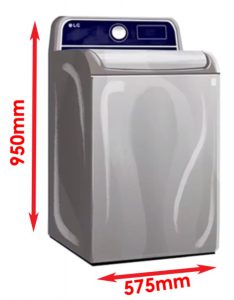How much space do I need for a laundry?
The laundry is perhaps the most “versatile” space in a residential area. It can be a standalone room, or it can be attached to an existing one like the bathroom or the living room. It can even be configured to connect directly to a patio or yard, for those times you want to sun-dry your clothes.
Like any other room in the house, though, planning the size of the laundry involves already having an idea of what type of equipment and amenities you would want to fit to it. As such, there is no standard size.
Standard Washing Machine Size
The standard washing machine has a size of 600mm wide, 600mm in depth and 850mm high. Manufacturers vary the size of each machine slightly depending on the model. In addition, the clearance that washers and dryers require for ventilation which is generally 100mm.

For ventilation you would need an extra 10cm clearance from the walls and the floors to ensure proper operation. This space would be enough to let cool air circulate around the machine, preventing overheating. Fortunately, front-loading appliances can accommodate other appliances or even a storage space atop it. You could also have the storage space underneath the washing machine, making front-loading easier so you don’t have to stoop down.
On the other hand, top-loading washing machines take up a little less floor space (some as small as 50cm in width and depth) but would need more than a meter’s worth of allowance at the top. If you’re designing a laundry around this washing machine, you cannot stack anything on top of it so you would have to allot additional floor space anyway.
Ideally, laundries need anywhere from 1.2 to 1.5 meters of clearance in front of every appliance to ensure unobstructed mobility. These guidelines are outlined by Livable Housing Australia. Your draftsman should be able to work with the space you have, from laying out everything on fixed locations in the room to using modular designs such as the European laundry layout that tucks everything away into cupboards and pocket doors.
What you need to consider
No matter what room you are planning, the primary consideration should always be how you would make it work for you. As such, the first question would be, “How do you do your laundry?”

- Do you use a front-loading or a top-loading washing machine and dryer?
- Do you want to have all your laundry equipment within easy reach at all times, or stowed neatly away in cabinets?
- How big of a bench, sink, and storage area would you need?
- How big is your laundry trough (most common ones hold about 45L of water)?
Ideally, you need enough space to work comfortably with whatever equipment you have now and whatever you are planning to buy in the future. Even how often you do your laundry would come into consideration, as infrequent use could mean you could save space by building your laundry space into the kitchen or bathroom.
But there is another consideration you would need to look into aside from the size of your washing machine and dryer — the clearance you need in order to safely operate them.


Hi guys,
While searching for the average size of washing machines I cam across your page.
Where most of it make perfect sense, I do have to tell you of a typo.
The standard washing machine has a size of 60mm wide, 60mm in depth and 850mm high.
I think you mean a size of 600mm wide, 600mm in depth and 850mm high.
It would be awesome if they only took up 60mm, but alas we need to assign a bit more space.
What a typo to make! thanks Micheal.